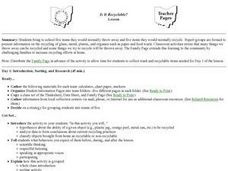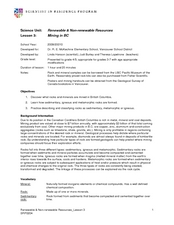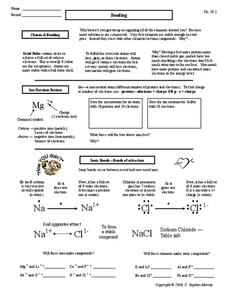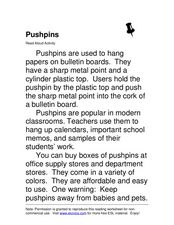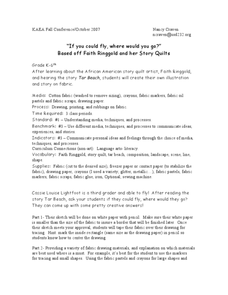Curated OER
Amazing Carbon
Explore carbon and bonding with this learning exercise. First, class members read a short excerpt about carbon and its characteristics. In response to the reading, they draw an electron dot diagram of carbon as well as diagrams of...
Curated OER
Metals vs. Non-Metals
In this elements worksheet, students compare and contrast the characteristics of metals and non-metals. Students practice drawing Lewis dot diagrams and writing ion notation. This worksheet has 9 word problems, 8 matching questions, and...
Curated OER
Is It Recyclable?
Learners bring to school five items they would normally throw away and five items they would normally recycle. Expert groups are formed to present information on the recycling of glass, metal, plastic, and organics such as paper and...
Curated OER
Less vs. Fewer
When should you use less, and when should you use fewer? Straighten out this dilemma with a helpful resource about using less vs. fewer based on sentence context clues. After reading detailed instructions and examples, young learners...
Curated OER
Renewable and Non-Renewable Resources: Mining in B.C.
Students explore energy by categorizing rocks. In this British Columbia geology lesson, students define many different vocabulary terms associated with mining such as sedimentary, igneous, and metamorphic. Students utilize sample rock...
K12 Reader
Charge It!
Electrify your pupils' interest in conductors and insulators with a brief reading passage! After reading the text, learners respond to five questions that relate to the content of the passage.
K12 Reader
Comparative or Superlative?
Is this the easiest or hardest exercise for practicing superlatives and comparatives? Your class can find out if it's easier or harder than what they've done before by changing the underlined adjectives into comparatives or superlatives,...
Curated OER
Bonding
In this bonding activity, students read about the two different types of chemical bonding: ionic and covalent bonds. Students review ion notation and oxidation numbers. This activity has 24 fill in the blank, 2 drawings, and 4 short...
Curated OER
More Chemical Bonding
In this chemical bonding activity, students review the three types of compounds: ionic, covalent, and polyatomic. Students practice drawing the covalent bonds of given compounds. This activity has 5 drawings and 13 fill in the blank...
Curated OER
WHAT'S ORGANIC?
Students explore how certain foods come to be certified "organic." They write the words "organic" and "synthetic" and given the definitions of each. Students are given dictionaries. They are asked: "What is organic food?" Students grow...
Curated OER
Phineas Gage: Concept Analysis
Prepare for teaching Phineas Gage: A Gruesome but True Story About Brain Science with this written analysis of the book. The analysis includes a summary, considerations for teachers, project ideas, and a list of additional resources that...
Curated OER
Pushpins--Read Aloud Activity
In this read aloud worksheet, 2nd graders read a passage about pushpins and their function. This passage is on a second grade reading level. There are no questions with this worksheet.
Curated OER
If You Could Fly, Where Would You Go?
Young scholars explore story quilts. In this cross curriculum literacy and art lesson, students listen to the story Tar Beachand discuss the art form of story quilts as used by Faith Ringgold. Young scholars sketch their own "Where Would...
Curated OER
Electric Circuits
Students explore energy by completing an electricity worksheet. In this conductors lesson, students define the energy related vocabulary terms circuit, electronics, conductor and semi-conductor before examining computer chips in class....
Curated OER
Indians in Georgia
Students investigate technology used by Native Americans by examining their creations. In this Native American math lesson, students examine the overall area of Mississippian Indian mounds that were built hundreds of years ago....
Curated OER
Money Vocabulary
In this money learning exercise, students match money vocabulary with their meanings and money amounts. Students complete 20 matches total.
Curated OER
Causal Patterns in Density Phenomena
Students realize that density exists. They develop a mental model of density-to realize that something is going on that they cannot see to account for differences between materials.
Other popular searches
- Non Metals
- Non Metals
- Metals Non Metals Metalloids
- Highly Reactive Non Metals
- Extraction Non Metals
- Smetals and Non Metals
- Highlyrecative Non Metals
- Metals Non Metals Medallions


